News Articles
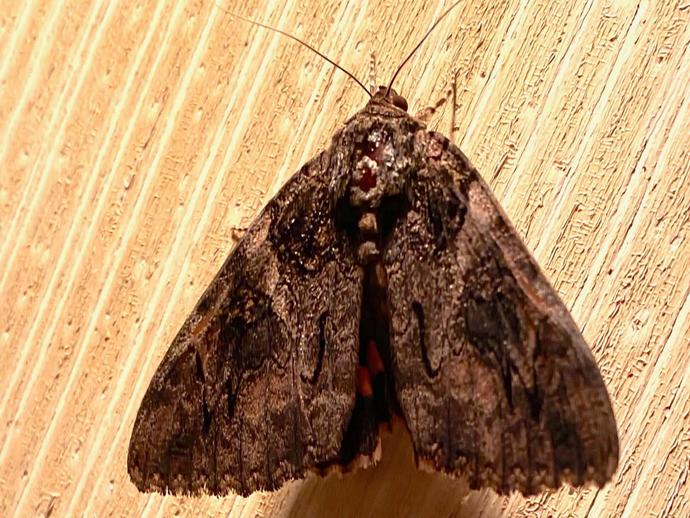
We're counting down my top five favorite finds from Saturday's Virginia BioBlitz 2020 ...
September 30, 2020
We're counting down my top five favorite finds from Saturday's Virginia BioBlitz 2020, and number three is the very first critter I spotted that morning, hanging out right on my front porch. This is an underwing moth (genus Catocala)! At first glance, underwing moths just look like fairly large, drab, well-camouflaged moths. However, the moment you startle one and it takes flight, you immediately notice what makes it unique: the dull forewings conceal a pair of brightly colored hindwings! Check out the slow-motion video I shot to see just what those hindwings look like in flight! So what's the purpose of having visually-striking wings that are usually concealed? When these moths are startled by a predator and take flight, ...

Join us live on the VMNH Facebook page at 6 p
September 30, 2020
Join us live on the VMNH Facebook page at 6 p.m. this evening, as Assistant Curator of Archaeology Dr. Hayden Bassett speaks about his upcoming tenure as the newest member of the museum's curatorial team!
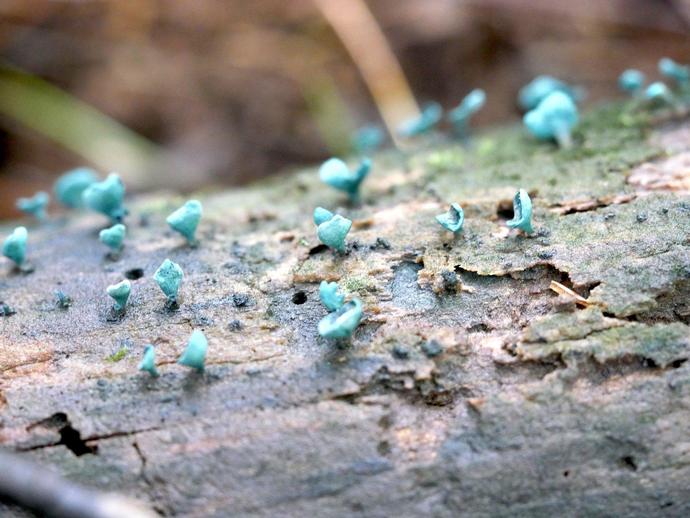
I'm continuing my top five favorite finds from Saturday's Virginia BioBlitz 2020 with my #4 ...
September 29, 2020
I'm continuing my top five favorite finds from Saturday's Virginia BioBlitz 2020 with my #4 pick: the Chlorociboria fungus! While it may look like a satellite image of an alien planet, this is a photo of tiny fruiting bodies from a fungus belonging to the genus Chlorociboria. There are two common species of this fungus found in temperate areas -- Chlorociboria aeruginascens and Chlorociboria aeruginosa -- but the only way to tell the difference between the two is by examining the spores under a microscope, so we'll just say it's one of them and leave it at that! What struck me about this fungus, of course, is its striking blue color. The fruiting bodies produce a pigment called Xylindein, and not only does it cause the ...

On Saturday, VMNH Associate Curator of Invertebrate Zoology Dr
September 28, 2020
On Saturday, VMNH Associate Curator of Invertebrate Zoology Dr. Kal Ivanov, Curator of Mammalogy Dr. Nancy Moncrief, and Research Technician Liberty Hightower came up to my place to take part in the Virginia BioBlitz 2020. We found more than 100 cool species, and this week, I'm going to count down my top five favorite critters that we found, starting with today's update: the eastern fence lizard (Sceloporus undulatus)! Eastern fence lizards are not particularly rare; alongside five-lined skinks, they're one of the most commonly encountered lizards in Virginia. However, they have been eluding me for months and running away before I could snap a photo, so I was thrilled to finally photograph this tiny juvenile! These ...

On Saturday, four museum staff members took part in the Virginia BioBlitz 2020!
September 28, 2020
On Saturday, four museum staff members took part in the Virginia BioBlitz 2020! Organized by the Virginia Academy of Science (VAS), people from all over the Commonwealth joined in on the event, venturing outdoors from 9 a.m. to 5 p.m. on Saturday to record every single species they could find and log it on a free app called iNaturalist. The goal was for scientists and citizen scientists across the state to record 100,000 observations and 6,500 different species. At the end of the day, more 111,000 observations were recorded, along with more than 6,600 different species! Of that number, the four pictured staff members contributed 113 different species, all found on the property of VMNH Administrator of Science Ben Williams. ...

Many people are currently enjoying the mass migration of birds to the south
September 28, 2020
Many people are currently enjoying the mass migration of birds to the south. Another often missed migration is occurring this weekend at Anglers Park in Danville, Virginia. The Red-spotted Newt, a salamander that lives as a larva in the water, lives on land as an eft, and heads back to the water to reproduce as an adult, is undergoing a mass migration back to breeding ponds. The juvenile efts which have lived in the surrounding forests for several years are now becoming adults and they are heading to their natal ponds to breed in the fall, winter, and spring. As the newt travels during the day and night, they are not worried about being eaten by predators. They are brightly colored to warn potential predators not to eat ...
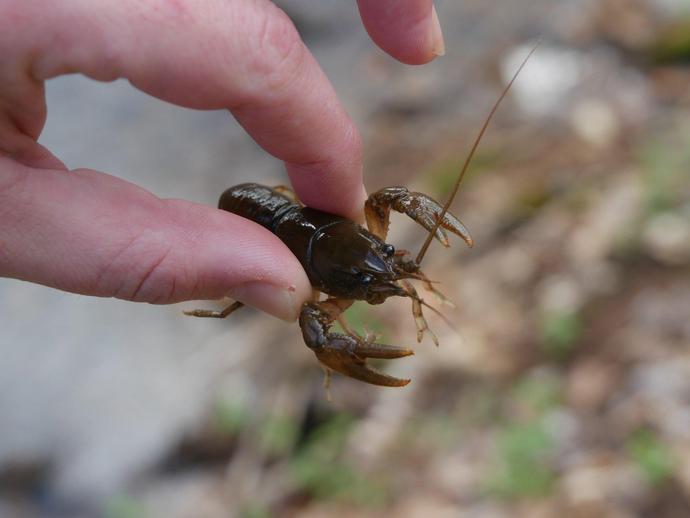
Moving forward ...
September 27, 2020
Moving forward, #BenInNature will highlight a previously posted nature update every Saturday and Sunday, but don't fret fans! New updates will continue to be posted Monday - Friday! The following post was originally published March 31, 2020. These little guys go by many names: crayfish, crawfish, crawdads, and mud bugs, just to name a few. There are three different families of crayfish, but the southeastern United States boasts more crayfish diversity than anywhere else in the world, all belonging to the family Cambaridae, which contains more than 330 species spread across nine genera. I had initially hoped to identify the pictured crayfish down to genus, but as it turns out, poking around the internet looking at taxonomic ...
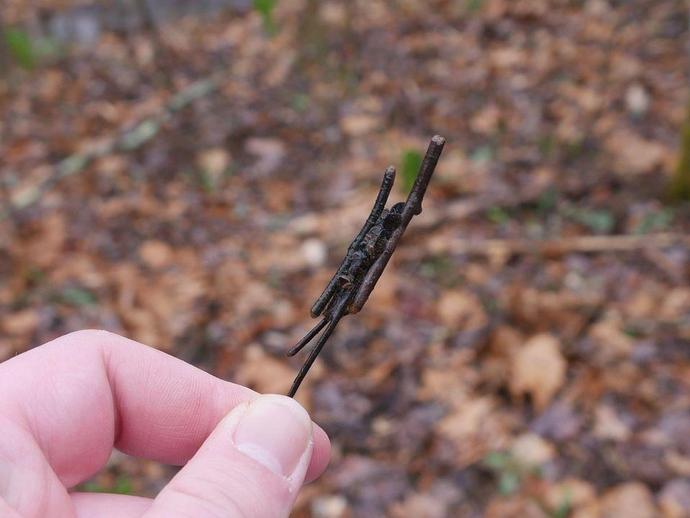
Moving forward ...
September 26, 2020
Moving forward, #BenInNature will highlight a previously posted nature update every Saturday and Sunday, but don't fret fans! New updates will continue to be posted Monday - Friday! The following post was originally published March 30, 2020. At first glance, these photos might look like I just found some twigs that got stuck together ... and that's exactly what the caddisfly wants you to think. Caddisflies (order Trichoptera) are a large group of insects that spend their larval stage underwater. As adults they resemble small moths, and with good reason; they're closely related to moths and butterflies. The adults are also known as "sedgeflies," and most fly fishermen probably have a few flies in their tackle box designed ...
Did you know sharks have been prowling the waterways of our planet for over 400 million years?
September 25, 2020
Did you know sharks have been prowling the waterways of our planet for over 400 million years? In this episode of "Tales of Ancient Life", Assistant Curator of Paleontology Dr. Adam Pritchard puts the spotlight on some of the shark species that existed 14 million years ago off the coast of what we now know as Virginia by highlighting fossilized shark teeth found at the Carmel Church Quarry in Caroline County, Virginia!
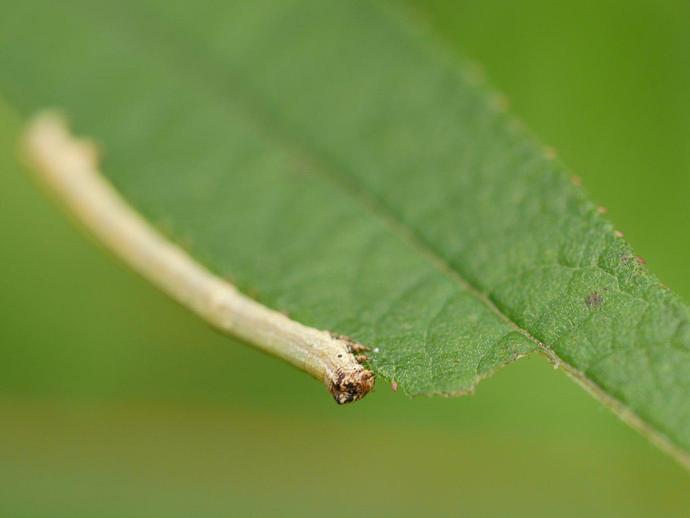
Inchworms ...
September 25, 2020
Inchworms, like the one seen here with a leaf it's been munching on, are caterpillars belonging to the family Geometridae. The name "Geometridae" comes from Ancient Greek and means "to measure the Earth." This name is derived from the unique way that inchworms move around, almost as though they're taking careful measurements. Unlike many caterpillars, inchworms don't have legs running the entire length of their body; instead, they have several pairs of legs at the front of their body and two or three pairs at their posterior end. To move around, they clasp with their front legs, draw their hind end forward, and then clasp with their hind legs and push the front part of their body forward. When they draw their hind legs up, ...

PUBLIC HOURS UPDATE Please note that beginning October 2 ...
September 24, 2020
PUBLIC HOURS UPDATE Please note that beginning October 2, the museum will be open to visitors on Fridays and Saturdays from 9 a.m. to 5 p.m. and closed all other days. We hope you can visit us soon!
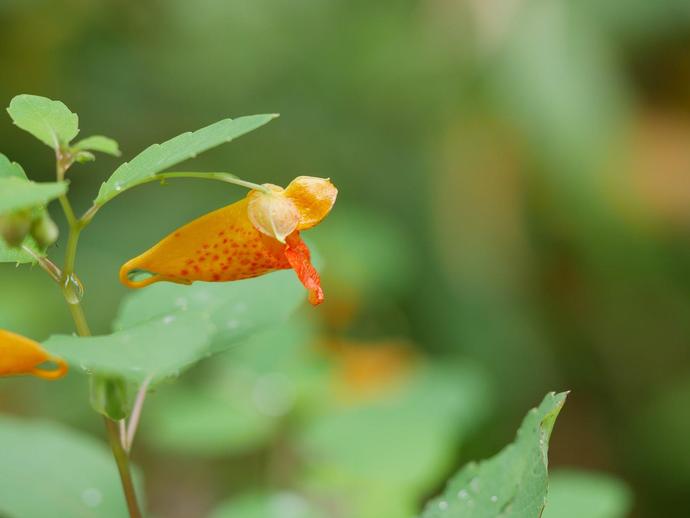
These beautiful little flowers belong to common jewelweed (Impatiens capensis) ...
September 24, 2020
These beautiful little flowers belong to common jewelweed (Impatiens capensis), an annual that can be found throughout much of eastern North America. You can find it in ditches and along creeks, and it blooms from the late spring into the early fall (it's in bloom right now, at least in my neck of the woods in Patrick County). If you like having hummingbirds around, don't cut down any jewelweed you find on your property! Hummingbirds are one of the main pollinators of this plant, alongside bumblebees. Hummingbirds are particularly efficient pollinators for jewelweed because their long beaks allow them to get to the delicious nectar in the flower's nectar spur, which is that little curved tube you can see at the back of the ...

VMNH Research Associate Jason Gibson ...
September 23, 2020
VMNH Research Associate Jason Gibson, who is also a member of the Virginia Herpetological Society, recently spotted several marbled salamanders (Ambystoma opacum) at Dan Daniel Park in Danville! These striking mole salamanders spend most of their time hiding in burrows or beneath logs, but according to Jason, the females are now arriving at dry vernal pools (small wetland areas that are filled with shallow water in winter and spring but are often dry in summer and fall) to lay their eggs. The females will stay with the eggs and guard them until the pool fills with water. Thanks for sharing, Jason!
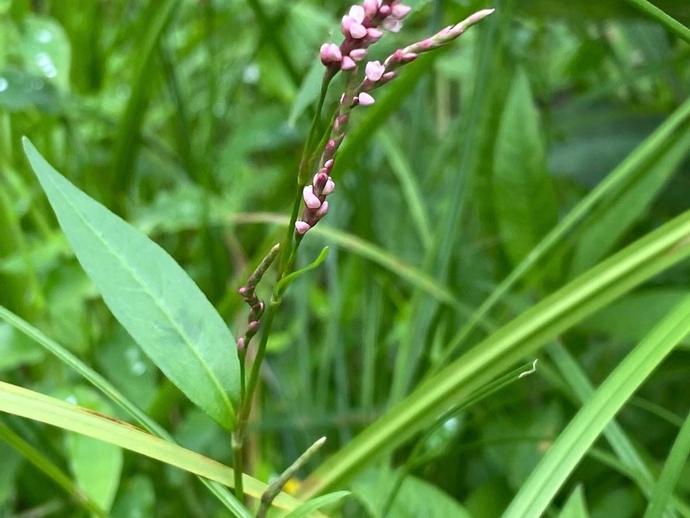
Pennsylvania smartweed (Persicaria pensylvanica) is a flowering plant in the buckwheat family ...
September 23, 2020
Pennsylvania smartweed (Persicaria pensylvanica) is a flowering plant in the buckwheat family, and if you've been strolling through a damp area lately, you have probably seen it in bloom. These plants love moist, poorly-draining soil; these two photos were taken next to a creek and next to a roadside drainage ditch, respectively. If you have drainage issues in your yard or garden, this plant can become a nuisance as it will often spread and crowd out your other plants. However, if you love birds, you might just want to keep it around! This plant provides both food and cover for a variety of birds. Ducks and geese love eating the seeds, along with doves, pheasants, bobwhites, and about 50 others! (Mice and raccoons also ...
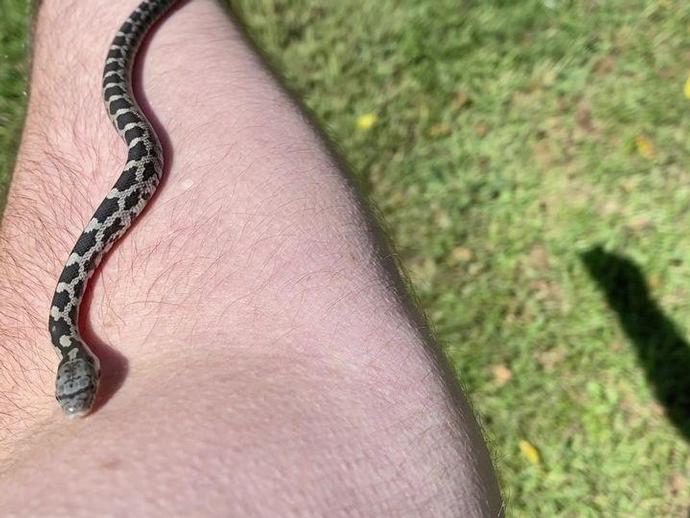
What is Virginia's most misidentified snake?
September 23, 2020
What is Virginia's most misidentified snake? Based on the number of identification requests received by the Virginia Herpetological Society, it's probably this little guy. In this video, VMNH Administrator of Science Ben Williams shows off a friendly little snake that you might just spot in your own backyard.

This is the goldenrod soldier beetle (Chauliognathus pensylvanicus) ...
September 22, 2020
This is the goldenrod soldier beetle (Chauliognathus pensylvanicus), and I can't help but feel like a bit of a creep sharing these photos of intimate moments between these insects. However, in my experience, it's harder to find these beetles NOT mating than it is to find them mating. Feel free to write your own joke here! These beetles can be found throughout a large portion of North America, and they're particularly common in the Midwest. They're mainly active in August and September, and if you have a lot of goldenrod on your property, they're very easy to spot because they emerge in huge numbers. While they're most closely associated with goldenrod, they can be found on a wide variety of flowers, including Queen Anne's ...

I was very excited when I found this snake in my bathroom last week ...
September 21, 2020
I was very excited when I found this snake in my bathroom last week, which is a statement that has probably never been typed before. This is a Diadophis punctatus edwardsii, the Northern ring-necked snake. It's one of 14 different subspecies of ring-necked snake! Ring-necked snakes aren't generally counted alongside the big three venomous snakes of Virginia (copperhead, cottonmouth, and timber rattlesnake), but they are mildly venomous. However, as evidenced by the fact that I'm holding this one in my bare hand, they don't present a threat to humans. They have small rear-facing fangs and aren't aggressive. This one didn't even bother to hit me with the foul-smelling musk that it can release from its anal glands (and I was ...
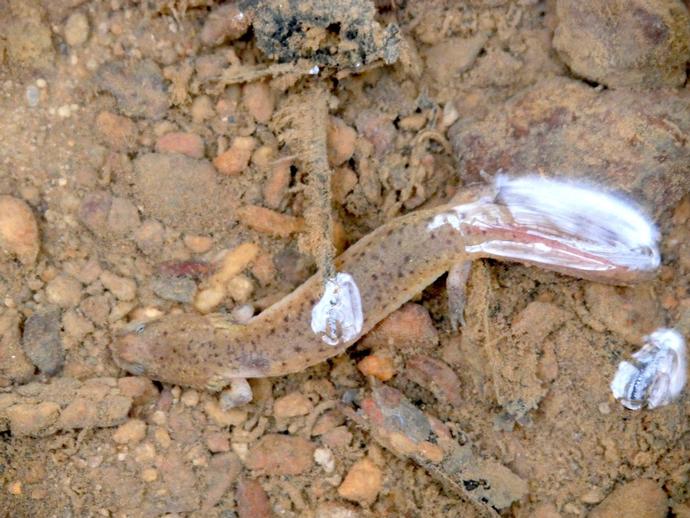
Moving forward ...
September 20, 2020
Moving forward, #BenInNature will highlight a previously posted nature update every Saturday and Sunday, but don't fret fans! New updates will continue to be posted Monday - Friday! The following post was originally published March 29, 2020. Many folks know that frogs (or at least a lot of species of frogs) don't emerge from their eggs fully-formed. Instead, they go through a larval stage, swimming around ponds and puddles as legless tadpoles. Salamanders, which are amphibians like frogs and toads, have a similar stage in their lives. Unlike tadpoles, larval salamanders have legs. They also have laterally flattened paddle-like tails to help them swim through the water and exposed gills that stick out from their necks. ...
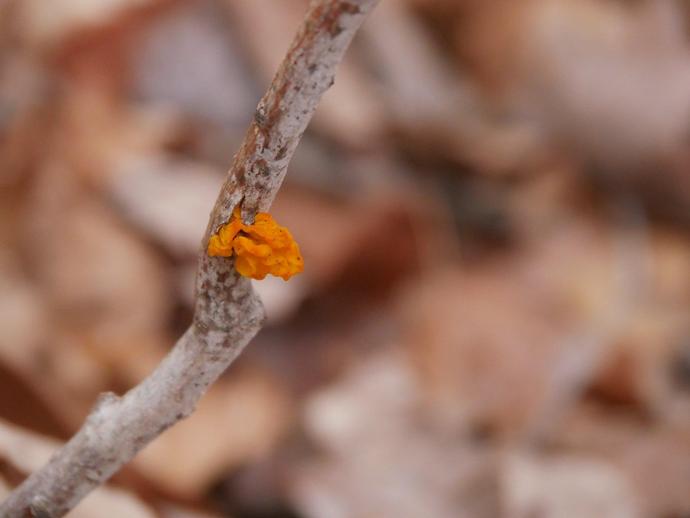
Moving forward ...
September 19, 2020
Moving forward, #BenInNature will highlight a previously posted nature update every Saturday and Sunday, but don't fret fans! New updates will continue to be posted Monday - Friday! The following post was originally published March 28, 2020. When I was a little kid, I was always on the hunt for A Good Stick, which all little kids are able to easily identify. A Good Stick is one that is more or less straight and has enough structural integrity to poke any number of things without breaking. Often, I would find a stick that didn't pass muster, usually because it was rotting and crumbling apart. These reject sticks often had this weird yellow-orange fungus growing out of them, and I always wondered what it was. As it turns out, ...
In this episode of "Museum Minute" ...
September 18, 2020
In this episode of "Museum Minute", VMNH Educator Terri Robertson highlights Dunkleosteus, one of the fiercest predators of our planet's ancient waters from over 350 million years ago! "Museum Minute" is a series of weekly videos produced by VMNH education staff that highlights specimens and displays residing inside the museum's exhibit galleries!

The other day I spotted this unusual vine on my property ...
September 18, 2020
The other day I spotted this unusual vine on my property, covered in what looked like tiny potatoes. As it turns out, that isn't too far from the truth. This is Dioscorea polystachya, commonly referred to as Chinese yam! As the name suggests, this plant is not native to the U.S. and is considered an invasive species. It originated in China but can now be found throughout East Asia. It was introduced to the U.S. in the 1800s or early 1900s, and interestingly enough, it was introduced in Europe in the 1840s to help combat the northern European potato famine. The vines of Chinese yams can grow up to 16 feet long, and they produce flowers that smell like cinnamon, giving the plant its second common name: Cinnamon vine. The ...
After a short hiatus, Assistant Curator of Paleontology Dr
September 18, 2020
After a short hiatus, Assistant Curator of Paleontology Dr. Adam Pritchard returns with another episode of "Tales of Ancient Life"! In this episode, Dr. Pritchard highlights the fossil skull of Diorocetus, an approximately 14 million year old baleen whale discovered at the Carmel Church Quarry in Caroline County, Virginia. This particular toothless whale lived its final weeks - if not months - with a massive jaw fracture. What could have caused this injury? Could it have been a head-on collision with another whale? Maybe it was suffered during an attack by a predator, such as Megalodon? Watch to find out!
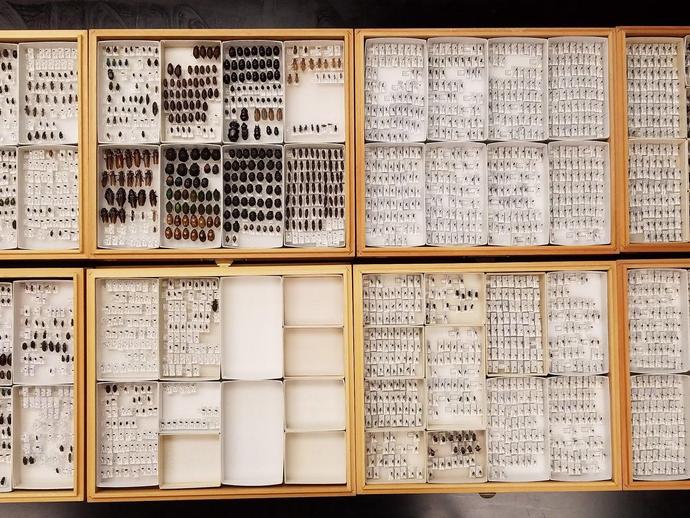
The museum's invertebrate collection recently increased by nearly 3 ...
September 18, 2020
The museum's invertebrate collection recently increased by nearly 3,000 expertly identified bees and beetles (and a few wasps, flies, and true bugs) thanks to generous donations from VMNH Research Associate Dr. Art Evans and Virginia Tech graduate student Robert Ostrom! The donated materials represent 396 different species, chiefly of Virginia origin. Donations such as these not only contribute specimens to our growing collection, but represent an invaluable resource to studying the ever-changing biodiversity of the Commonwealth. Such collections can also provide data for future research using new analytical methods and technologies, allowing scientists to study them in ways not yet conceived.
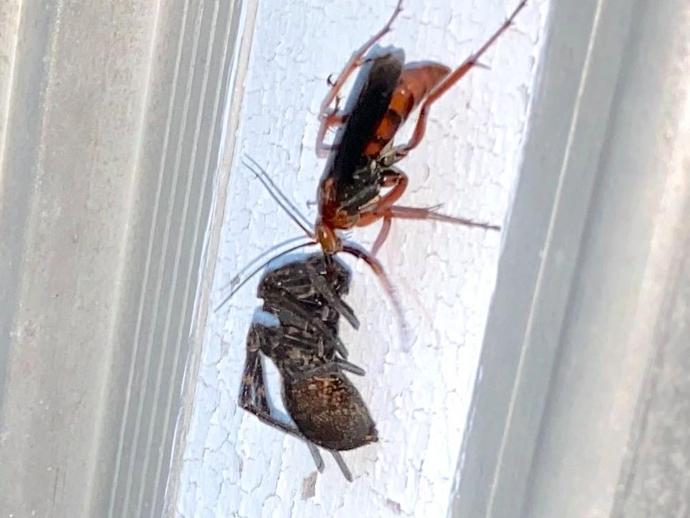
A lot of folks seem to hate wasps, but what about a wasp that hunts spiders?
September 17, 2020
A lot of folks seem to hate wasps, but what about a wasp that hunts spiders? This is Tachypompilus ferrugineus, also known as the rusty spider wasp or red-tailed spider hunter! These large wasps have a wide range, stretching from Canada all the way down to South America! These wasps are solitary, meaning that they don't live in large communal nests, but instead dig small, simple nests in dry soil. The adults eat nectar from a wide variety of flowers. Their larvae, however, are not vegetarians (and if you've been following these nature posts for a while, you probably already know where this one is going). Rusty spider wasps are spider hunters, and they prefer to target large wandering spiders. In Virginia, that means ...

It was all about entomology (the study of insects) today during the museum's Virtual Homeschool ...
September 16, 2020
It was all about entomology (the study of insects) today during the museum's Virtual Homeschool Science & Engineering Academy program for ages 6 and older! Remote homeschoolers virtually shared insects they had collected before class, while VMNH educators taught the importance of insects using specimens from the education collection. Museum educators even showcased fossil insects during a virtual tour of the Solite Quarry section of the Uncovering Virginia exhibit!
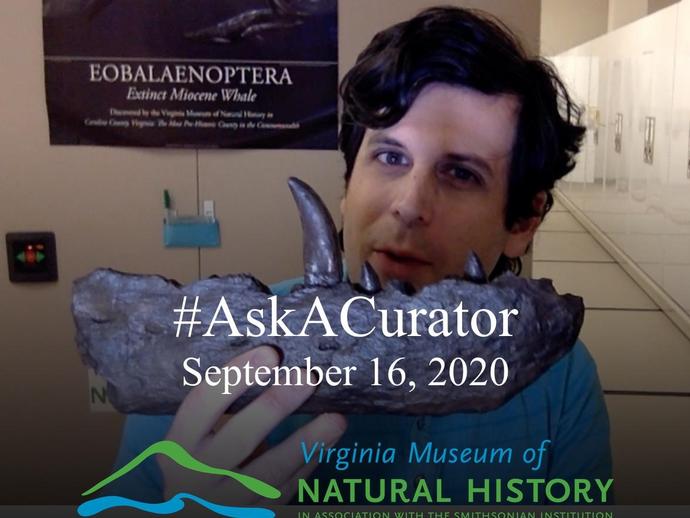
Today is #AskACurator day!
September 16, 2020
Today is #AskACurator day! We received two great questions from curious youngster Ronan, who asked: "How many dinosaurs are there?" and "How do you get the dinosaurs?" Fortunately, Assistant Curator of Paleontology Dr. Adam Pritchard has the answers... There are over 1,000 different named types of dinosaurs discovered so far, and many more remain to be discovered. We discover new kinds of dinosaurs by digging in rocks that are between 230 and 66 million years old, because that is when dinosaurs lived. However, if you want to find living dinosaurs, you should check-out my answer to Ioan's question earlier today, which can be found posted on the museum's Facebook page!

I have returned from my vacation ...
September 16, 2020
I have returned from my vacation, and what better way to commemorate the return of the daily nature post than by celebrating North America's most iconic butterfly? The monarch butterfly (Danaus plexippus) is almost certainly the most famous butterfly in North America, not only because of its beauty, but also because of the incredible journey that these butterflies take each year. In late summer/early fall, monarchs in the U.S. and Canada migrate thousands of miles to Florida and Mexico where they overwinter (just like your older relatives!). There is also a population of monarchs west of the Rockies that tends to overwinter in southern California, but they also pop in Mexico. The vast majority of eastern monarchs end ...
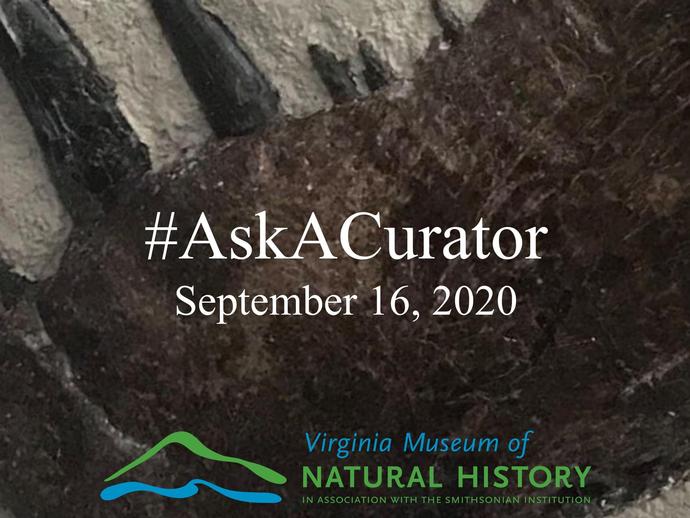
Today is #AskACurator day!
September 16, 2020
Today is #AskACurator day! One of the questions we received came from Ioan, who asked: "Were the cassowaries related to dinosaurs?" Great question, Ioan! Here is an answer from Assistant Curator of Paleontology Dr. Adam Pritchard... Cassowaries are an incredible type of living, flightless bird with a big crest on top of their heads. It might surprise you, but birds are a type of dinosaur! They are the only ones that survived the great extinction 66 million years ago. So not only are cassowaries related to dinosaurs, but they are actually a type of dinosaur.
Initial Design of the VMNH Waynesboro Campus
September 15, 2020
Initial Design of the VMNH Waynesboro Campus
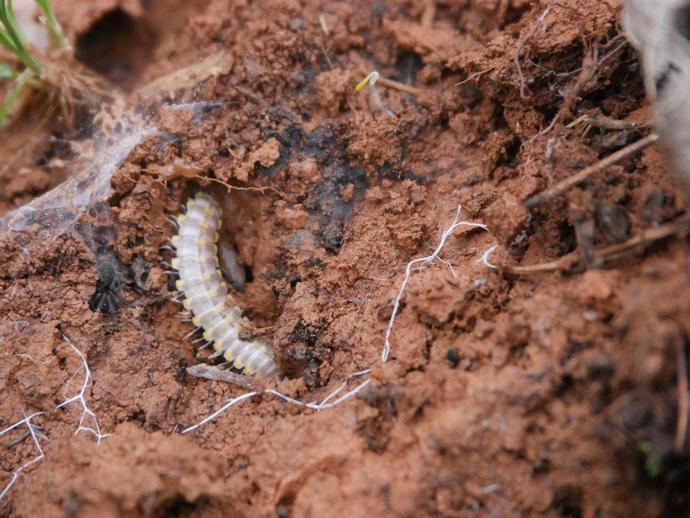
#BenInNature is on vacation!
September 15, 2020
#BenInNature is on vacation! While he's out, we're going to look back at the first daily nature updates from way back in March! The following post was originally published March 27, 2020. Yesterday, we talked about centipedes; today, we're going to talk about millipedes, the centipede's cool laid-back vegan cousin. According to myriapod expert Dr. Jackson Means, who is currently serving as a research technician at VMNH, this millipede is likely a juvenile Boraria stricta; once mature, it will have a dark black body with yellow spots to advertise its chemical defenses (this form of advertising is called "aposematism"). Those chemical defenses are no joke. If you ever pick up a similarly-colored millipede and smell it (look, ...
Where did coronovirus originate? That's the question for today's "Ask An Expert"!
September 15, 2020
Where did coronovirus originate? That's the question for today's "Ask An Expert"!

#BenInNature is on vacation!
September 14, 2020
#BenInNature is on vacation! While he's out, we're going to look back at the first daily nature updates from way back in March! The following post was originally published March 26, 2020. Centipedes aren't the most beloved creatures, but they're pretty fascinating. This is a bark centipede of the genus Scolopocryptops. So what's the difference between a centipede and a millipede? Centipedes and millipedes both belong to the subphylum Myriapoda, and they're both long and skinny and have a bunch of legs, but beyond that, the differences are night and day. Centipedes are fast-moving carnivores; millipedes are slow-moving detritivores (they eat dead organic material, mostly plant-based). Centipedes can inflict a painful, ...
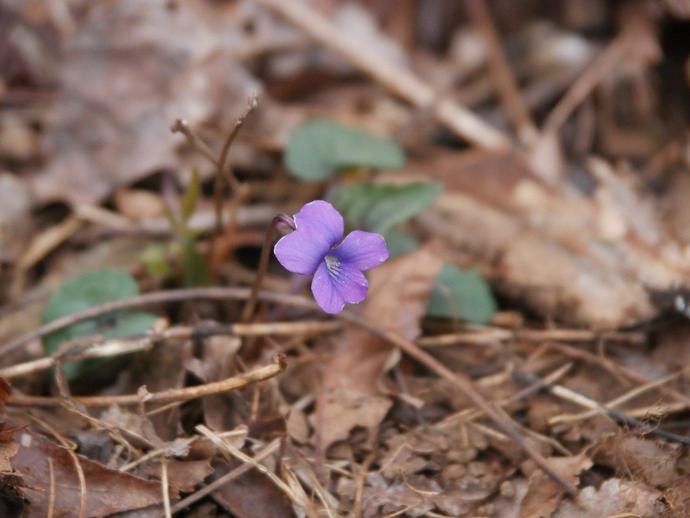
#BenInNature is on vacation!
September 13, 2020
#BenInNature is on vacation! While he's out, we're going to look back at the first daily nature updates from way back in March! The following post was originally published March 25, 2020. These tiny flowers often pop up in yards, and a lot of people even spritz them with weed killer. Many of those same people then go out and buy close relatives of this plant to decorate their flower beds. This is Viola sororia, better known as the common blue violet, wood violet, or wild violet. You might think that these are closely related to African violets; in fact, African violets belong to a different genus altogether! The most beloved members of the Viola genus are that perennial favorite, the pansy. Pansies were created by ...

#BenInNature is on vacation!
September 13, 2020
#BenInNature is on vacation! While he's out, we're going to look back at the first daily nature updates from way back in March! The following post was originally published March 25, 2020. These tiny flowers often pop up in yards, and a lot of people even spritz them with weed killer. Many of those same people then go out and buy close relatives of this plant to decorate their flower beds. This is Viola sororia, better known as the common blue violet, wood violet, or wild violet. You might think that these are closely related to African violets; in fact, African violets belong to a different genus altogether! The most beloved members of the Viola genus are that perennial favorite, the pansy. Pansies were created by ...
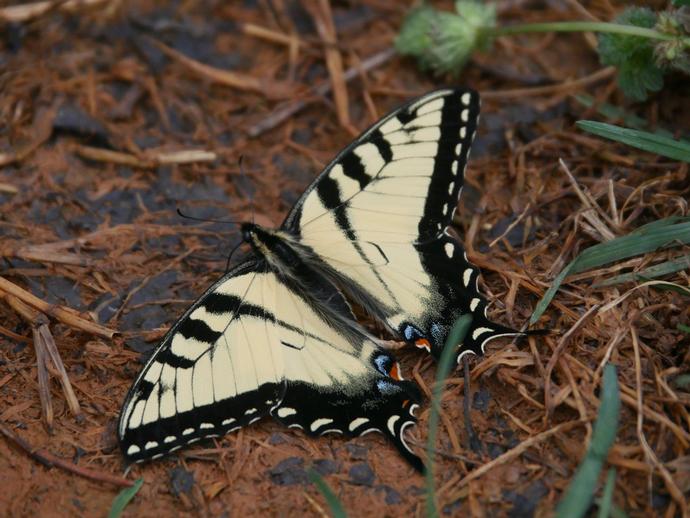
#BenInNature is on vacation!
September 12, 2020
#BenInNature is on vacation! While he's out, we're going to look back at the first daily nature updates from way back in March! The following post was originally published March 24, 2020. The eastern tiger swallowtail butterfly (Papilio glaucus) is one of the most recognizable butterflies in the eastern U.S. They can be spotted from spring through fall, during which time they can produce as many as three broods. While the adults may be beautiful to witness, the young caterpillars don't exactly inspire poetry; for their first few instars (phases between molts in the development of insect larva) they resemble bird droppings, which helps them avoid the attention of predators. As the caterpillars grow larger, they develop fake ...

VMNH is participating in #AskACurator day on Wednesday ...
September 12, 2020
VMNH is participating in #AskACurator day on Wednesday, September 16 and our research staff is eager to answer your questions! Have you ever wondered what the largest dinosaur fossil in the VMNH collections is? Maybe you're interested in becoming an archaeologist and want to know how to begin your career journey. Whatever your question, simply contact us via FB Messenger (you can just click the "Send Message" button below) before noon on Monday, September 14 with your question followed by "Ask A Curator"! Select questions and answers will be posted on the museum's Facebook page on September 16, while others will be replied to directly via FB Messenger!
Assistant Curator of Paleontology Dr
September 11, 2020
Assistant Curator of Paleontology Dr. Adam Pritchard loves dinosaurs and we love when National Geographic interviews him for his expertise!
In this episode of "Museum Minute" ...
September 11, 2020
In this episode of "Museum Minute", VMNH Educator Kayla Lacy highlights an Inuit clothing display, which can be found on exhibit inside the museum adjacent to the Harvest Foundation Hall of Ancient Life! "Museum Minute" is a video series produced by VMNH education staff that highlights specimens and displays that reside inside the museum's exhibit galleries.
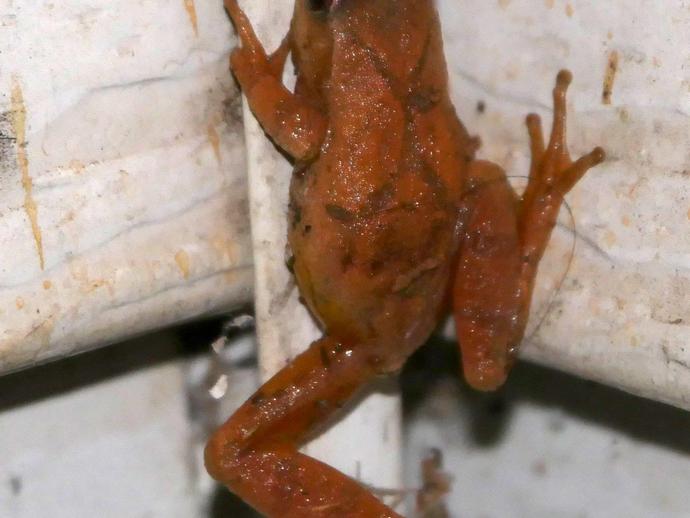
#BenInNature is on vacation!
September 11, 2020
#BenInNature is on vacation! While he's out, we're going to look back at the first daily nature updates from way back in March! The following post was originally published March 23, 2020. Have you ever walked past a pond or a swamp at night during the spring and heard a high-pitched peeping sound coming from about a million different sources? What you heard was the appropriately-named spring peeper (Psuedacris crucifer). These little guys (they can grow a hair over an inch long) are chorus frogs that breed during the early spring, and they're among the very first frogs that begin calling when the weather starts to turn warm. They prefer to live in the woods near bodies of water, and they emerge at night to hunt for insects ...

#BenInNature is on vacation!
September 10, 2020
#BenInNature is on vacation! While he's out, we're going to look back at the first daily nature updates from way back in March! The following post was originally published March 22, 2020. A fox squirrel stares into the distance, quietly contemplating the big questions: do I live to gather walnuts, or do I gather walnuts to live? The fox squirrel (Sciurus niger) is the largest species of tree squirrel in North America. While they can look similar to gray squirrels, they are slightly larger and have longer tails. They also exhibit a wider variety of coat colors, and they often have a white spot on the tips of their noses. While I've been seeing fox squirrels in Patrick County for years, they have only recently started ...
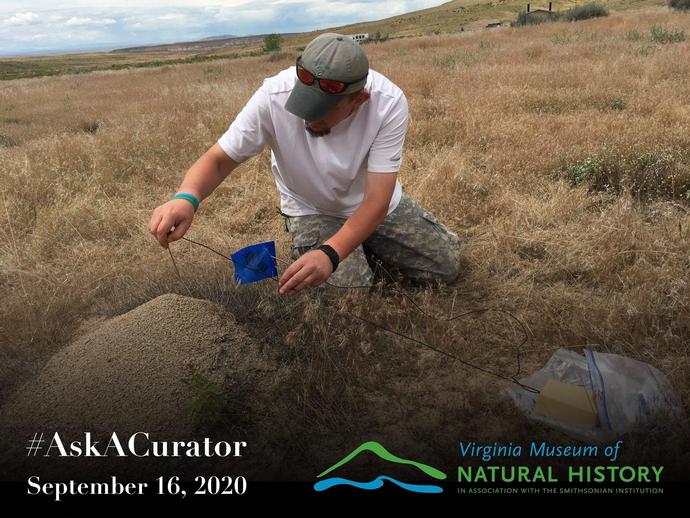
VMNH is participating in #AskACurator day on Wednesday ...
September 10, 2020
VMNH is participating in #AskACurator day on Wednesday, September 16 and our research staff is eager to answer your questions! Have you ever wondered what the largest dinosaur fossil in the VMNH collections is? Maybe you're interested in becoming an archaeologist and want to know how to begin your career journey. Whatever your question, simply contact us via FB Messenger (you can just click the "Send Message" button below) before noon on Monday, September 14 with your question followed by "Ask A Curator"! Select questions and answers will be posted on the museum's Facebook page on September 16, while others will be replied to directly via FB Messenger!

#BenInNature is on vacation!
September 9, 2020
#BenInNature is on vacation! While he's out, we're going to look back at the first daily nature updates from way back in March! The following post was originally published March 21, 2020. The male Northern Cardinal isn't exactly a rare bird, but it's still an eye-catching sight. Cardinals can be found as far north as southeastern Canada, as far south as Guatemala, and as far west as Texas. Males are a vibrant red while females are an olive color. Every so often, people spot yellow cardinals; these rare birds lack the enzyme that converts carotenoids (organic pigments found in plants) into red plumage. You probably know that the cardinal is the state bird of Virginia, but did you know that it's also the state bird of North ...
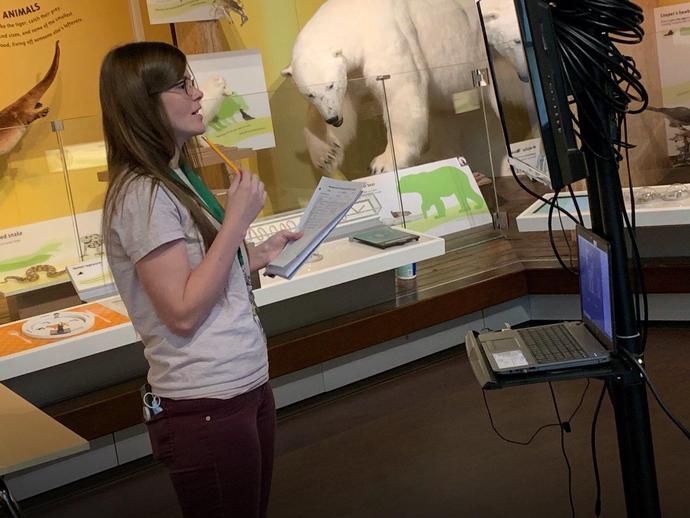
Registrations for the next session of the museum's Virtual Homeschool Science & Engineering ...
September 8, 2020
Registrations for the next session of the museum's Virtual Homeschool Science & Engineering Academy are now being accepted! On Wednesday, September 16, students will connect remotely with educators at the museum to explore the fascinating world of entomology (the study of insects)! The program is available for students ages 6-8, 9-11, and 12+. Visit www.vmnh.net/homeschool-education to learn more or email us at discover@vmnh.virginia.gov today! *In this picture, VMNH Educator Kayla Lacy stands inside the museum's "How Nature Works" exhibit gallery while discussing animal classifications with students during the first-ever Virtual Homeschool Science & Engineering Academy, which was held on September 2.
CAREER OPPORTUNITY: ARCHAEOLOGIST The museum is seeking a dynamic individual to assist the ...
September 8, 2020
CAREER OPPORTUNITY: ARCHAEOLOGIST The museum is seeking a dynamic individual to assist the museum's curator of archaeology in directing/overseeing field and laboratory work, conducting background research, cataloguing artifacts, writing grants, reports, and scholarly articles!

#BenInNature is on vacation!
September 8, 2020
#BenInNature is on vacation! While he's out, we're going to look back at the first daily nature updates from way back in March! The following post was originally published March 20, 2020. Hey everybody, it's a skunk cabbage! (Look, they can't all be cool salamanders). Symplocarpus foetidus, commonly known as skunk cabbage or swamp cabbage, is a pretty interesting plant. It can be found from Nova Scotia all the way down to North Carolina and Tennessee (while it's pretty common in southside Virginia, it's actually considered endangered in Tennessee). If you break the leaf of a skunk cabbage, you'll quickly understand how it earned its name; it releases a pungent odor, and it also releases a foul smell when it blooms. This ...

#BenInNature is on vacation!
September 7, 2020
#BenInNature is on vacation! While he's out, we're going to look back at the first daily nature updates from way back in March! The following post was originally published on March 19, 2020. Ben here! This morning, I looked underneath a potted plant in my yard and found this little fellow: a Northern red salamander (Psuedotriton ruber ruber). "Psuedotriton" is Latin for "False Triton," referring to the Greek sea god, which seems vaguely insulting to this awesome salamander. The Northern red salamander is the official state salamander of Virginia and they average 4-6 inches in length. Salamanders are amphibians just like frogs and toads, and this particular species is one of the lungless salamanders, which means it respires ...
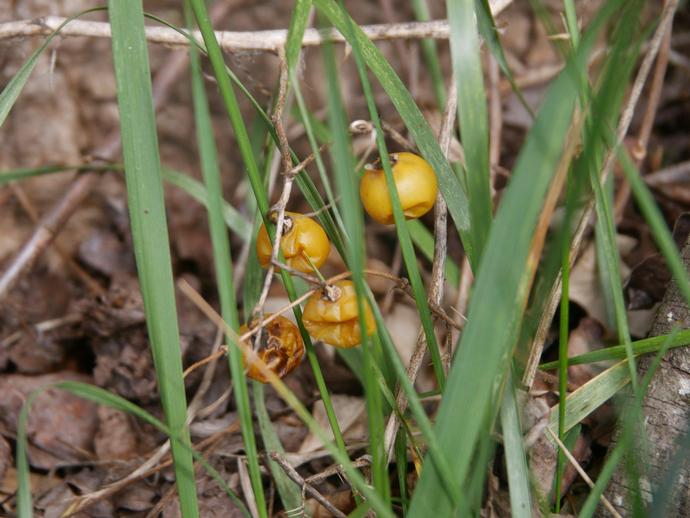
#BenInNature is on vacation!
September 6, 2020
#BenInNature is on vacation! While he's out, we're going to look back at the first daily nature updates from way back in March! The following post was originally published March 18, 2020. Administrator of Science Ben Williams here, checking in from the woods with another nature picture! You've probably seen these before, and if you're like me, you referred to them as "those weird little yellow tomato-looking things." As it turns out, that's not too far from the truth! This is Solanum carolinense, better known as the Carolina horsenettle. However, it is not a true nettle (nor is it a horse). It's a member of the nightshade family, which also includes tomatoes, potatoes, and eggplant among many, many others. Don't eat the ...
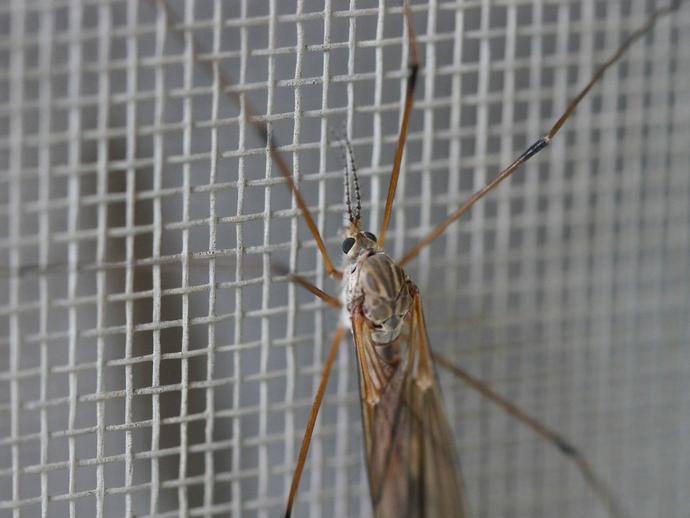
#BenInNature is on vacation!
September 5, 2020
#BenInNature is on vacation! While he's out, we're going to look back at the first daily nature updates from way back in March! The following post was originally published March 17, 2020. GAH! What is that? This is a macro shot of a crane fly (flies in the family Tipulidae). These flies look like giant mosquitoes, but have no fear; they're perfectly harmless. The adults only eat flower nectar. In addition to their mosquito-like appearance, crane flies can be easily spotted based on their clumsy, wobbly flight. They spend most of their lives as worm-like larvae popularly called "leatherjackets." These larvae eat roots, and they are sometimes considered a pest to those who like to maintain immaculate yards. In many parts of ...
In this episode of "Museum Minute" ...
September 4, 2020
In this episode of "Museum Minute", VMNH Educator Terri Robertson highlights the museum's Leafcutter Ant colony located inside the Suzanne M. Lacy Education Center! "Museum Minute" is a video series produced by VMNH education staff that highlights specimens and displays that reside inside the museum's exhibit galleries.
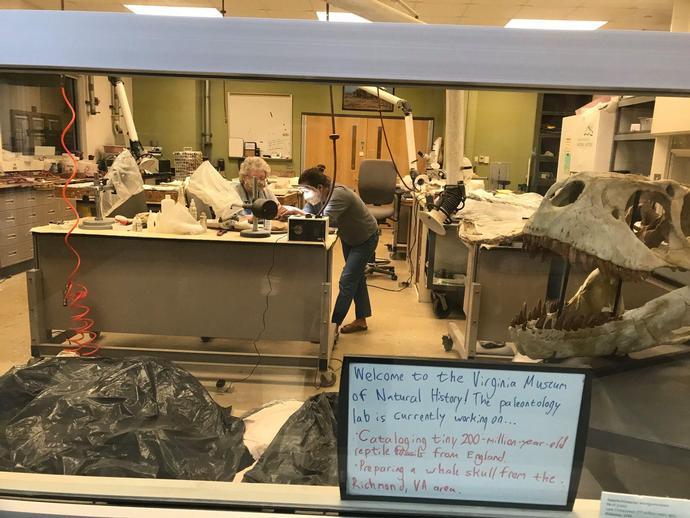
While VMNH Research Technician Lucy Treado (right) and research volunteer Alicia Lantz have ...
September 4, 2020
While VMNH Research Technician Lucy Treado (right) and research volunteer Alicia Lantz have dedicated much of their time to the museum's archaeology program in recent days, they still found time to continue their work inside the museum's paleontology lab this week!
Archives
2025
2024
2023
2022
2021
2020
2019
2018
2017
2016
2015
2014
2013
2012
2011
2010
2009
2008

Please Visit Us Soon
Hours:
Tuesday - Saturday: 10am - 4pm
Sunday: Noon to 4pm (Memorial Day Weekend through Labor Day Weekend only)
Monday: Closed
Admission:
$12 for ages 18-59
$6 for ages 3-17, seniors 60+, and college students
FREE for children under 3, museum members, members of ASTC Passport participating institutions, and EBT cardholders
My 4 year old son loves going to the museum. The exhibits are educational, interactive and kid-friendly.
”

 Hours & Admissions
Hours & Admissions Directions
Directions